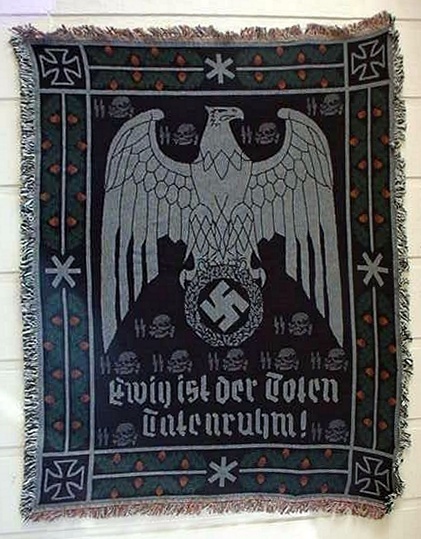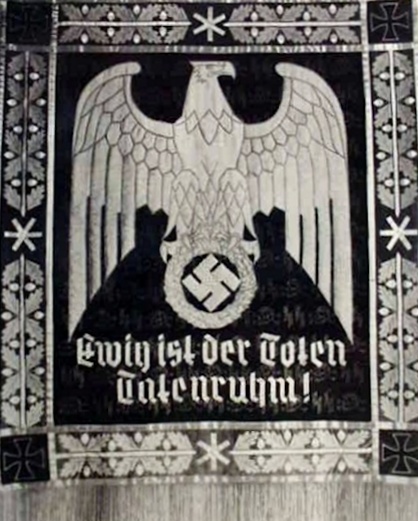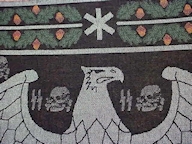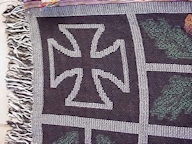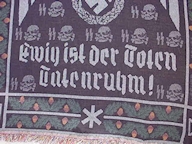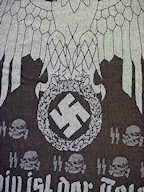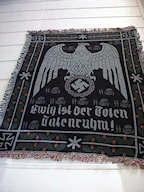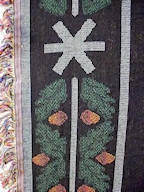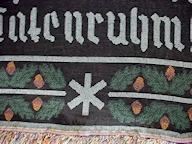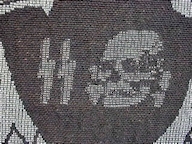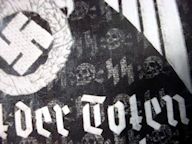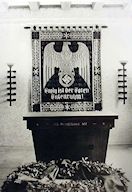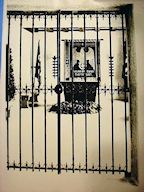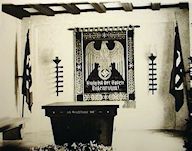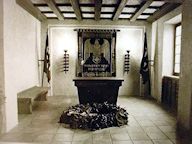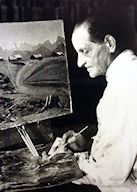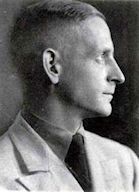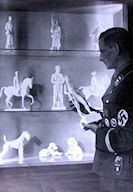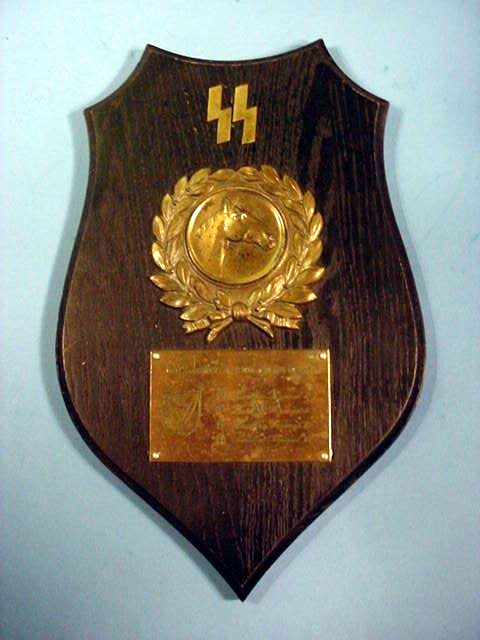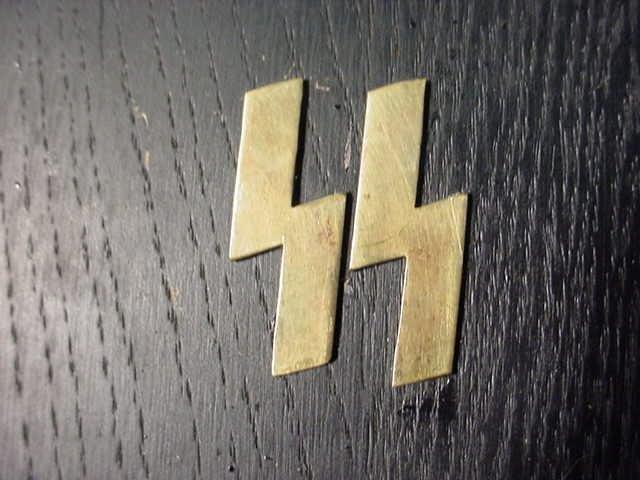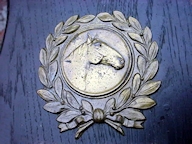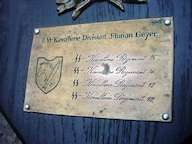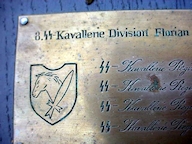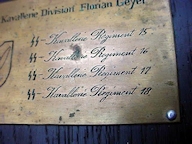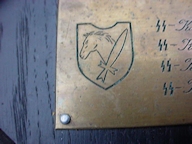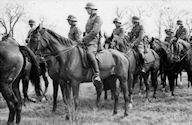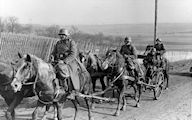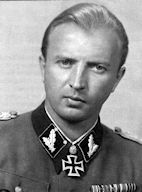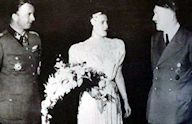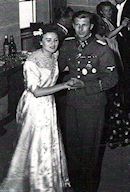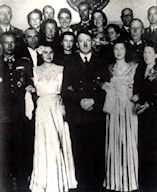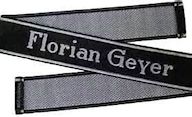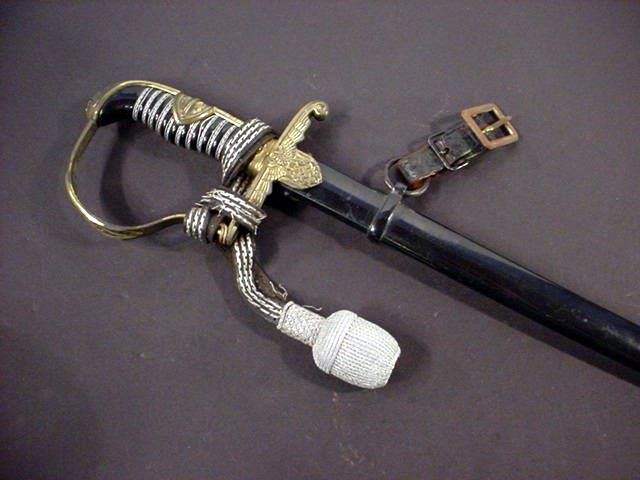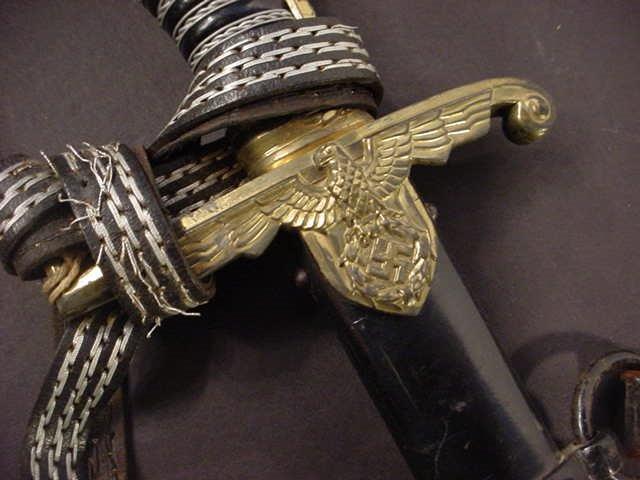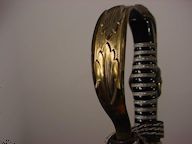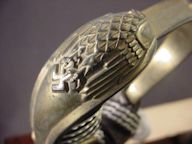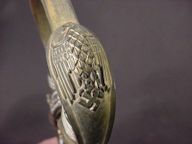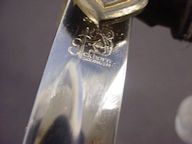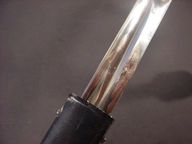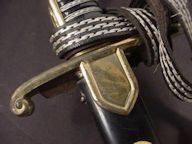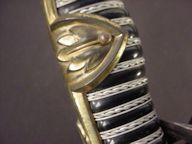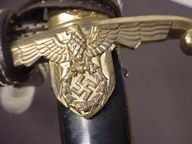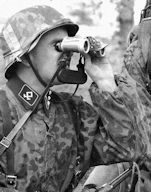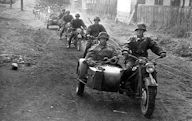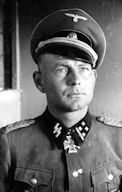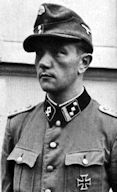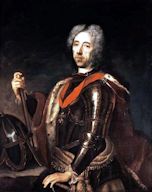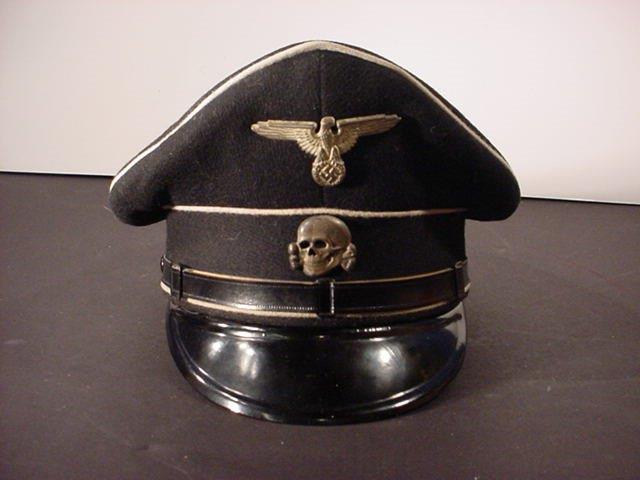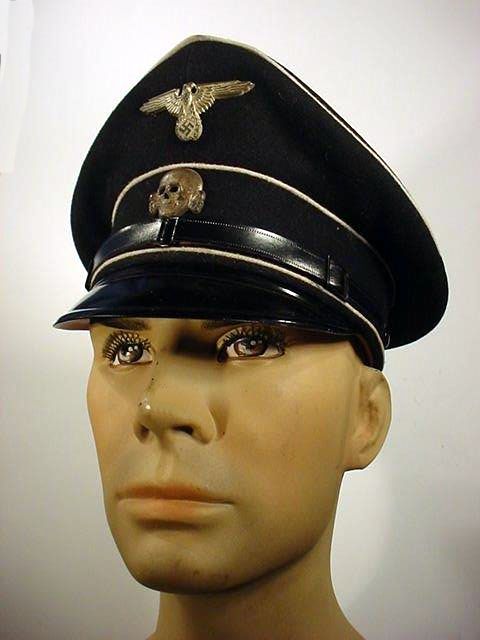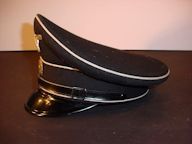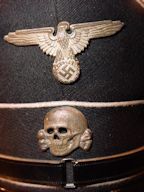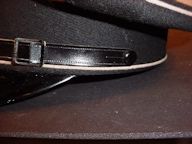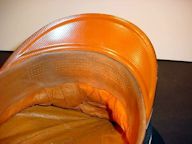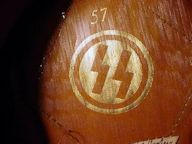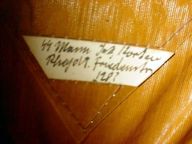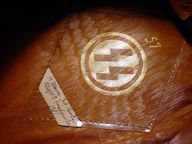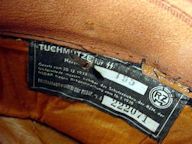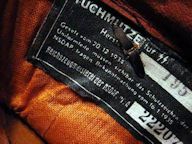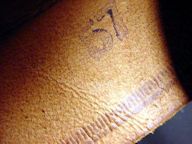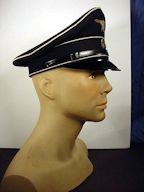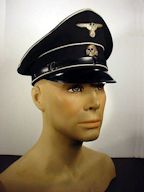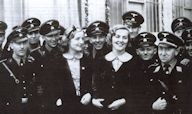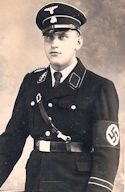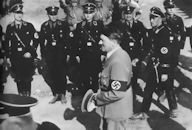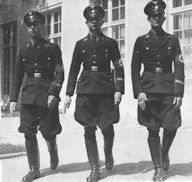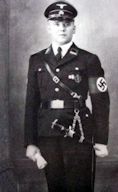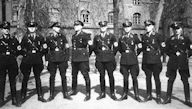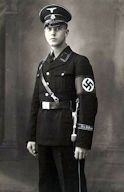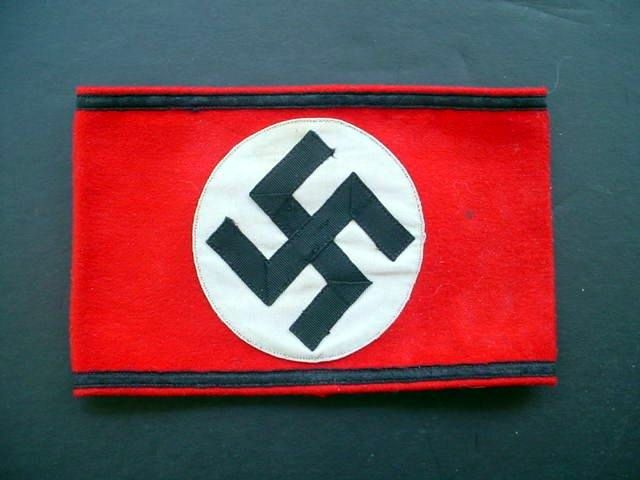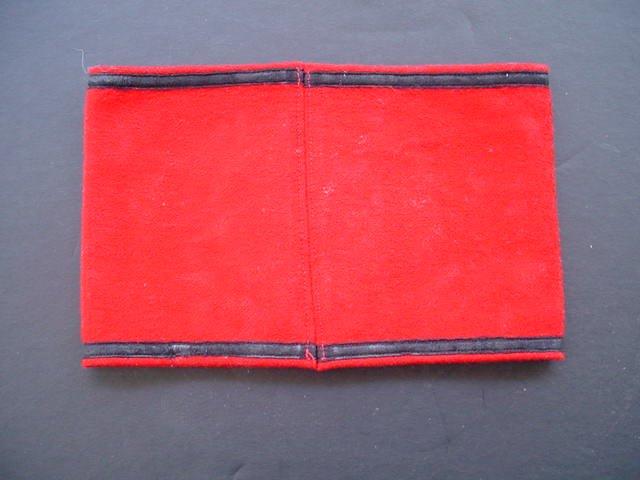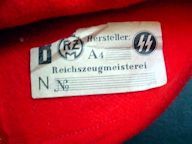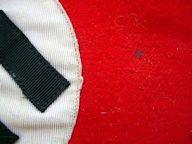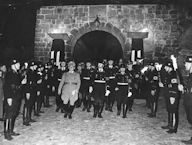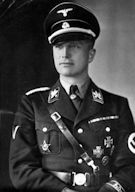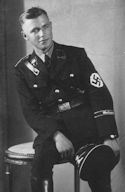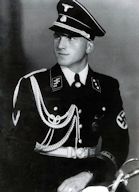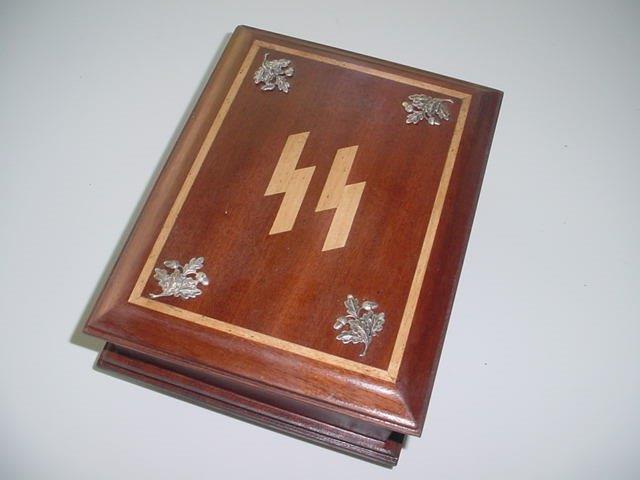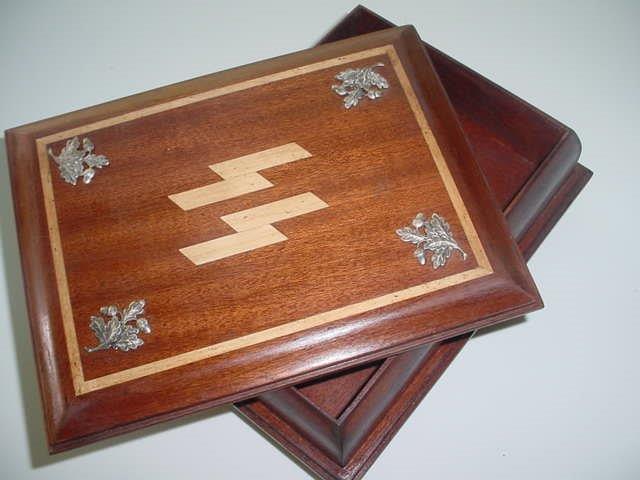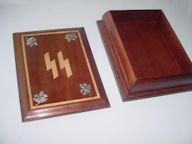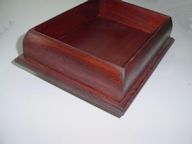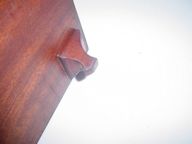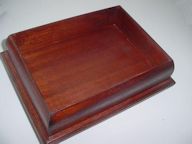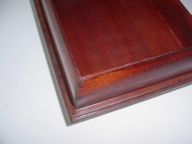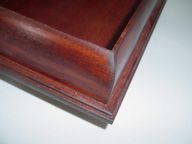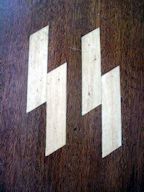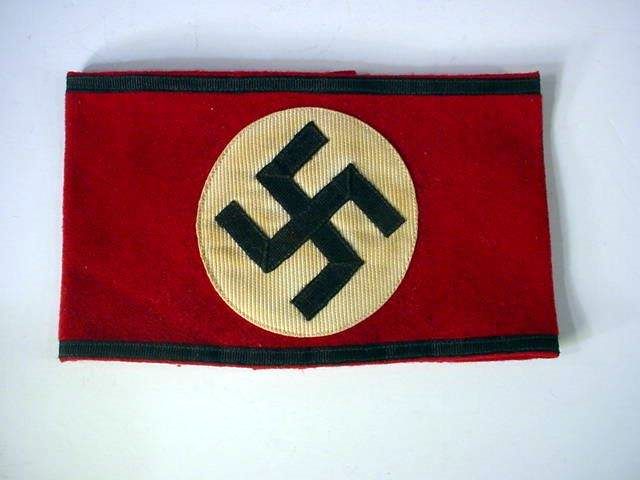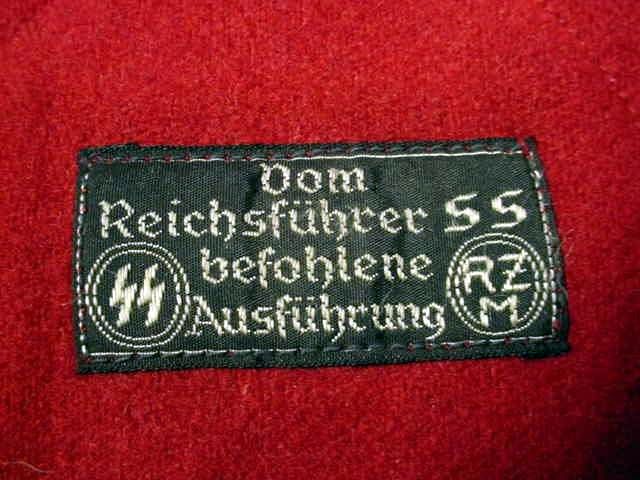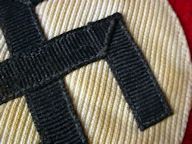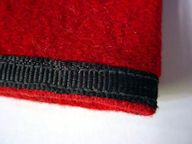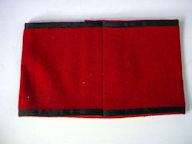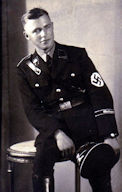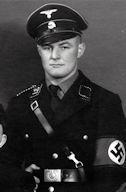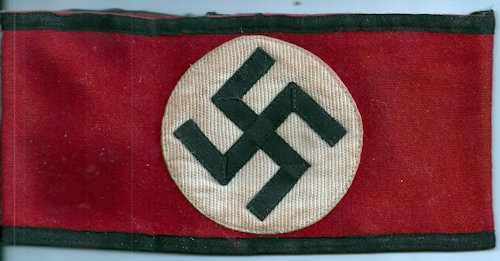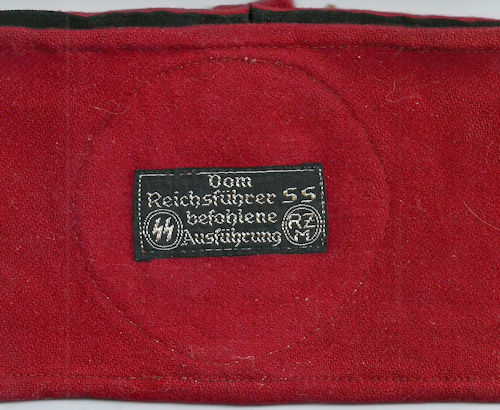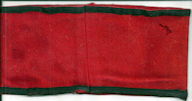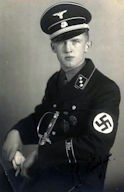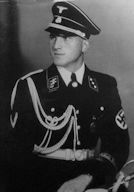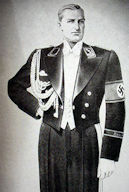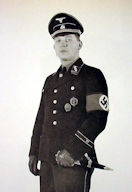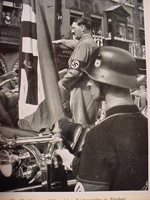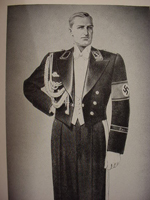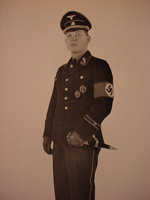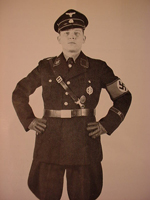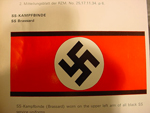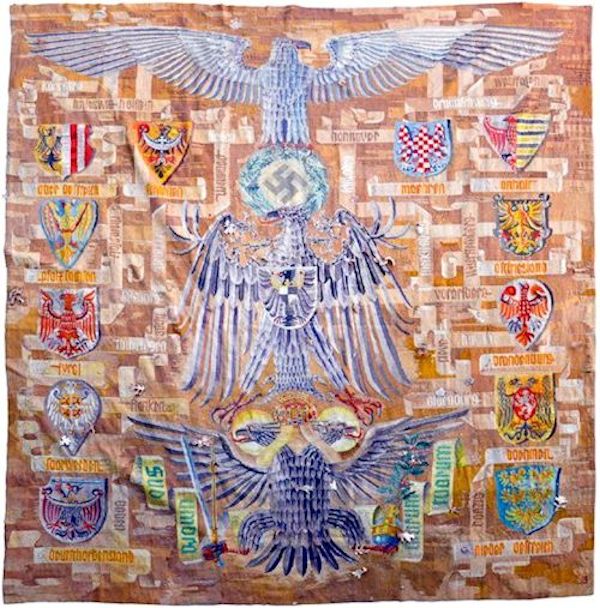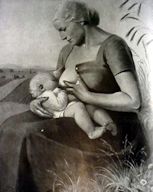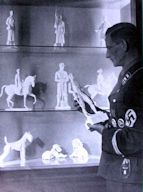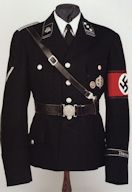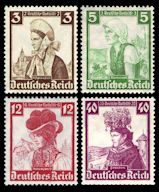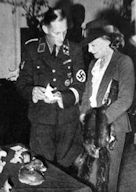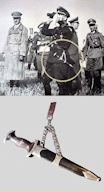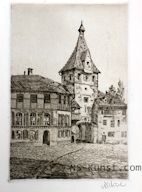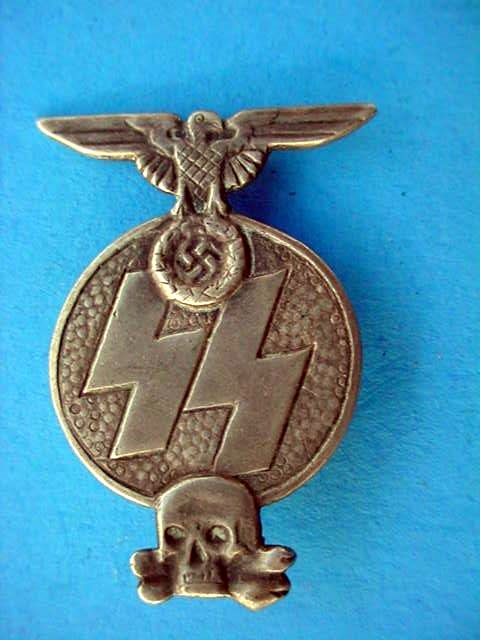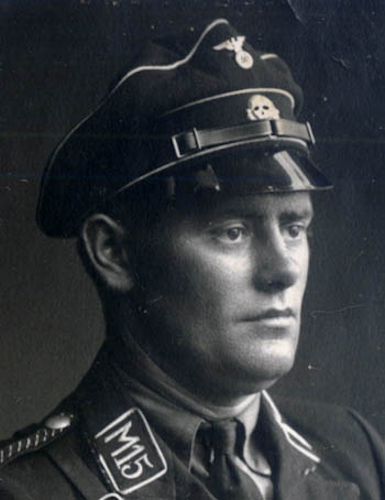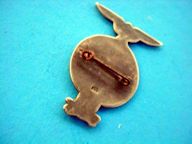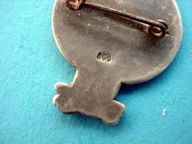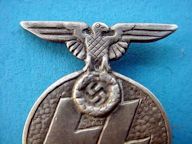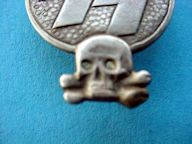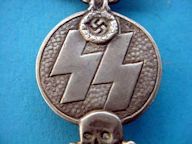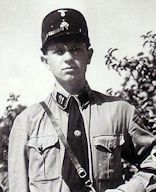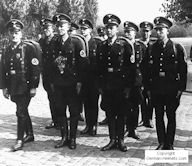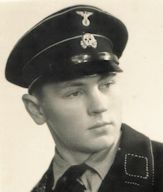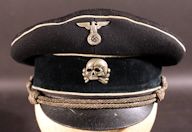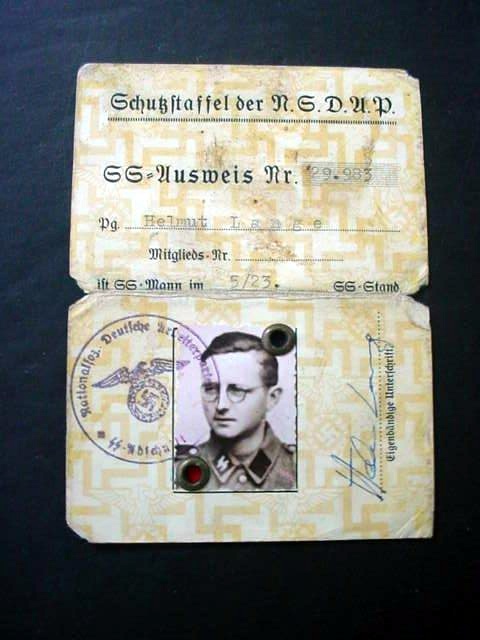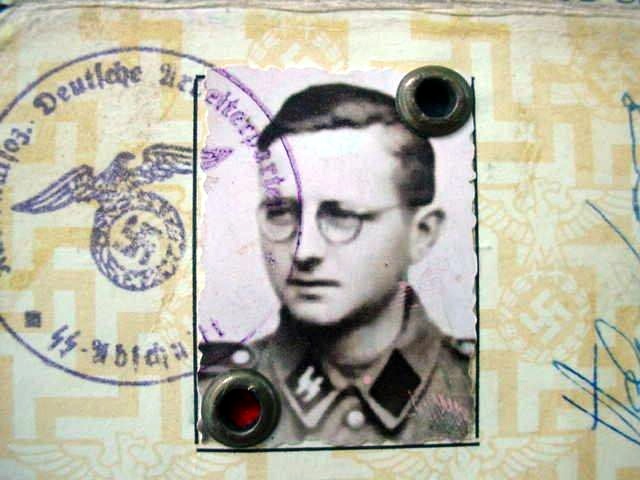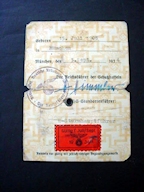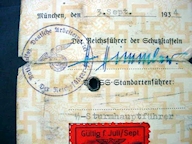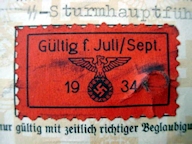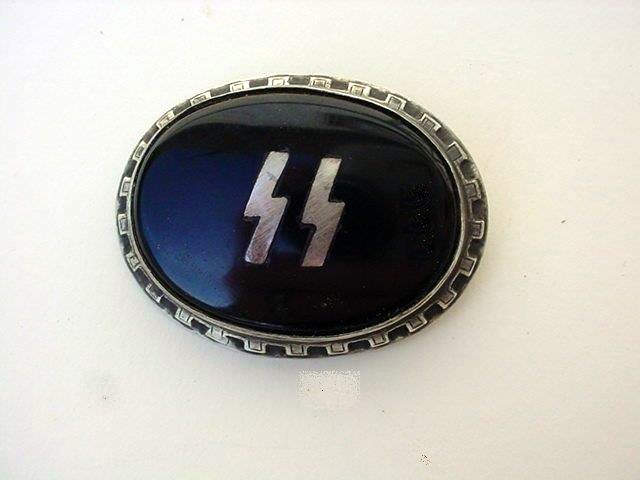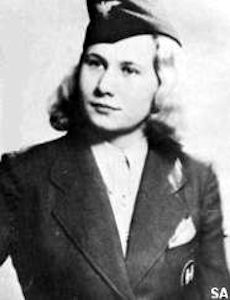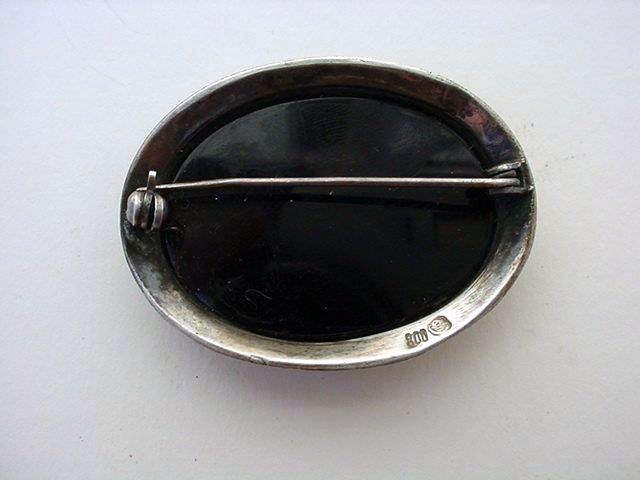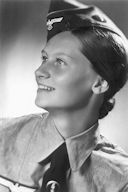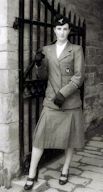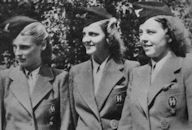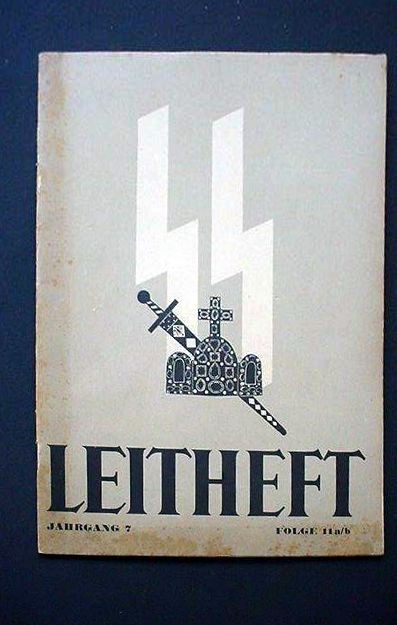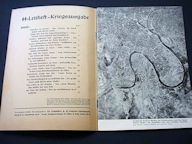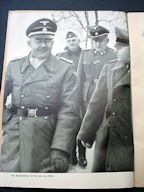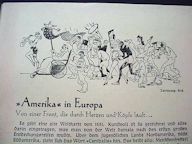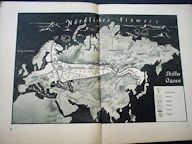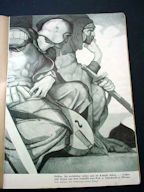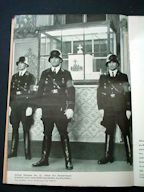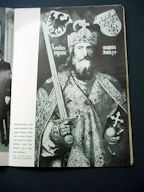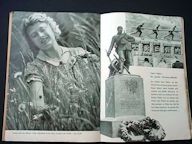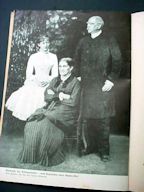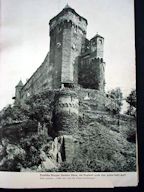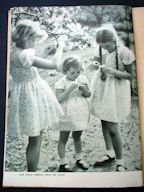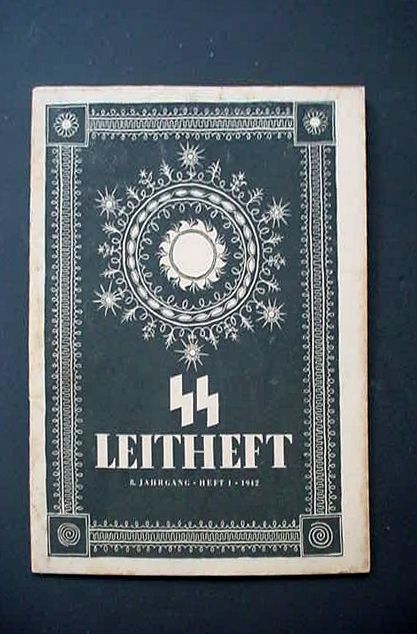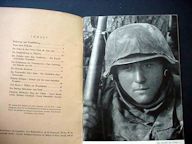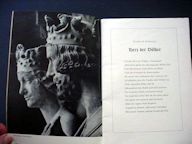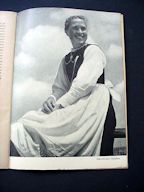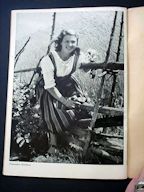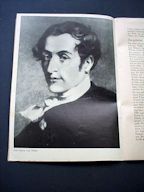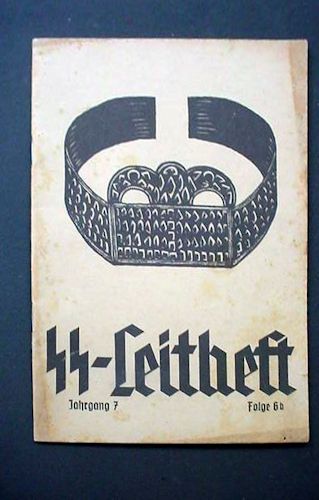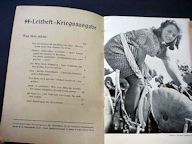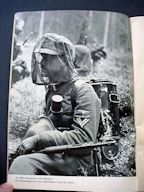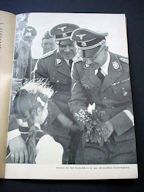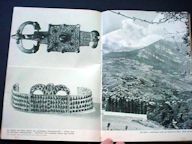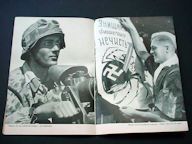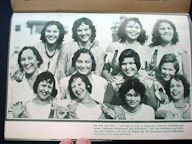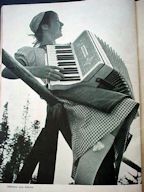|
|
Allgemeine-
Page 37
Fabulous Replica of SS-Totenkopf Death's Head Ring
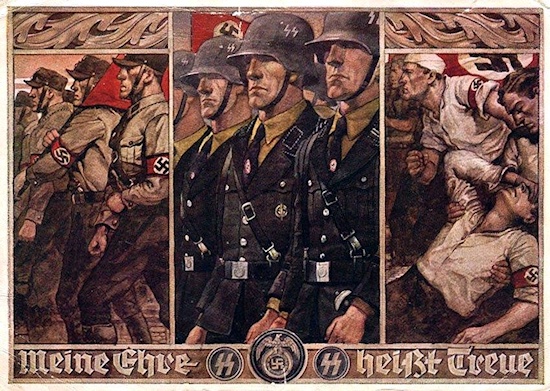 |
|
|
|
Museum-Re-created |
DESCRIPTION: Again, Germania International does not handle reproductions unless we see an item so prodigiously important that it should be re-created and offered to serious collectors who would never hope to see or even afford the original if such could ever be obtained. In this case, this item will in all likelihood never be found; it was the memorial tapestry from the city of Dachau (not to be confused with the famous concentration camp). In a quiet section of the 1,200-year-old town was a memorial to the  men who had been killed in the early street fighting against the ‘Red Front’ in the 30s and to the Waffen- men who had been killed in the early street fighting against the ‘Red Front’ in the 30s and to the Waffen- soldiers who had laid down their lives for Führer and Fatherland in the 40s (Second World War). Behind stalwart iron gates was a precious tapestry so revered that it sat behind an alter flanked by swastika flags and typical soldiers who had laid down their lives for Führer and Fatherland in the 40s (Second World War). Behind stalwart iron gates was a precious tapestry so revered that it sat behind an alter flanked by swastika flags and typical  wall torches. Here, ceremonies were held both Christian and semi-Pagan to honor these brave men. The tapestry bore the legend “Eternal are the dead indeed." (“Ewig ist der Toten Tatenruhm”). Above this legend is the figure of a German National Eagle whose total visage is completely wall torches. Here, ceremonies were held both Christian and semi-Pagan to honor these brave men. The tapestry bore the legend “Eternal are the dead indeed." (“Ewig ist der Toten Tatenruhm”). Above this legend is the figure of a German National Eagle whose total visage is completely  in its noble bearing. Then, all around the eagle are repetitive skulls and in its noble bearing. Then, all around the eagle are repetitive skulls and  runes. Its borders are decorated with oak leaves and acorns in vibrant color and also there can be seen four Hagel runes and this symbol was widely used by the runes. Its borders are decorated with oak leaves and acorns in vibrant color and also there can be seen four Hagel runes and this symbol was widely used by the  for its symbolic representation of unshakable faith in the NS-SS belief. You will also see it in the Himmler Ehrenring (Death’s-head ring) worn by members of the for its symbolic representation of unshakable faith in the NS-SS belief. You will also see it in the Himmler Ehrenring (Death’s-head ring) worn by members of the  and also in and also in  wedding rings. In the four corners of the tapestry are the Iron Crosses to represent the supreme valor of the departed, honorable, fighting men. Nothing could have been considered more sacred than this tapestry other than the Blutfahne (Blood Flag) as carried in the Munich Putsch. Where this original tapestry is today no one knows among the collectors and researchers. I personally hope it was hidden away in time to save it from the ravages and destruction brought to Germany by the “glorious” Allied enemy. wedding rings. In the four corners of the tapestry are the Iron Crosses to represent the supreme valor of the departed, honorable, fighting men. Nothing could have been considered more sacred than this tapestry other than the Blutfahne (Blood Flag) as carried in the Munich Putsch. Where this original tapestry is today no one knows among the collectors and researchers. I personally hope it was hidden away in time to save it from the ravages and destruction brought to Germany by the “glorious” Allied enemy.Professor and SS-Oberführer Karl Diebitsch and his sister, Elsie Seifert Professor Diebitsch was the official artist for the  having designed many of the having designed many of the  uniforms, uniforms,  daggers, and sword crests for daggers, and sword crests for  officers, postage stamps with the officers, postage stamps with the  theme, and several other important tapestries such as this one. We also present to you an actual rare prototype model 36 chained theme, and several other important tapestries such as this one. We also present to you an actual rare prototype model 36 chained  officer’s dagger by the professor on our pages at SS 36-14 You should go there for further information about Herr Diebitsch. Also see SS 36-15 to see another of his beautiful tapestry creations. His sister, Elsie Seifert, had early moved to America, but went back to Germany when Karl summoned her shortly after he was commissioned by the Reichsführer- officer’s dagger by the professor on our pages at SS 36-14 You should go there for further information about Herr Diebitsch. Also see SS 36-15 to see another of his beautiful tapestry creations. His sister, Elsie Seifert, had early moved to America, but went back to Germany when Karl summoned her shortly after he was commissioned by the Reichsführer- Himmler to create several important tapestries for the Reich. She was the artist who did the actual construction, while her brother was the designer. Mr. R. Johnston, our historical advisor, met both Professor Diebitsch and Frau Seifert in the early 1980s and interviewed both of them. Although of advanced age, he found them to be sharp, informative, and more than willing to tell of their beloved art. They both gave Mr. Johnston several pictures of tapestries and other art pieces they had accomplished while in Himmler to create several important tapestries for the Reich. She was the artist who did the actual construction, while her brother was the designer. Mr. R. Johnston, our historical advisor, met both Professor Diebitsch and Frau Seifert in the early 1980s and interviewed both of them. Although of advanced age, he found them to be sharp, informative, and more than willing to tell of their beloved art. They both gave Mr. Johnston several pictures of tapestries and other art pieces they had accomplished while in  employ, and this included the pictures of the employ, and this included the pictures of the  memorial tapestry in its place of honor at Dachau. Frau Seifert gave him pictures of many other tapestries they had created in the 30s and 40s, but the one that impressed him (Johnston) most was the Dachau Memorial Tapestry and when he saw these pictures that we show here, he said immediately that this masterpiece wall hanging just had to be created once again because it is so very meaningful. So, out of the pages of N.S.-SS history it comes forth once more and it is carefully and colorfully re-created. There is very little perceptible difference except for the fringe, but that couldn’t be helped. The workmanship is so very good that another tapestry made by the same company ended up being offered for $3,500 in a major European auction house whose staff thought it was authentic and from the N.S. “Braun Haus” in Munich, but when Mr. Johnston told them the facts it was withdrawn—these tapestries are really that fine. This re-creation is BIG: 68 x 50 inches.The colors are fast and they are washable. All in all, Mr. Johnston considers them to be a masterpiece of the weaver’s machine art. Here is your chance to own what can be considered a fitting tribute to true beauty perceived in cloth and dedicated to the hope of no more terrible ‘brother wars.’ memorial tapestry in its place of honor at Dachau. Frau Seifert gave him pictures of many other tapestries they had created in the 30s and 40s, but the one that impressed him (Johnston) most was the Dachau Memorial Tapestry and when he saw these pictures that we show here, he said immediately that this masterpiece wall hanging just had to be created once again because it is so very meaningful. So, out of the pages of N.S.-SS history it comes forth once more and it is carefully and colorfully re-created. There is very little perceptible difference except for the fringe, but that couldn’t be helped. The workmanship is so very good that another tapestry made by the same company ended up being offered for $3,500 in a major European auction house whose staff thought it was authentic and from the N.S. “Braun Haus” in Munich, but when Mr. Johnston told them the facts it was withdrawn—these tapestries are really that fine. This re-creation is BIG: 68 x 50 inches.The colors are fast and they are washable. All in all, Mr. Johnston considers them to be a masterpiece of the weaver’s machine art. Here is your chance to own what can be considered a fitting tribute to true beauty perceived in cloth and dedicated to the hope of no more terrible ‘brother wars.’
PRICE: $179.00 |
|
|
|
Plaque From the Florian Geyer |
DESCRIPTION: Here is a really great plaque from the office of  -Gruppenführer Hermann Fegelein, who commanded this -Gruppenführer Hermann Fegelein, who commanded this  cavalry division on three different tours of duty from April 1942 to January 1944. They fought bravely on the Eastern Front and fought in the Rzhev and the Orel sectors in central Russia until the spring of 1943. They were then involved in internal security and antipartisan duties and chalked up many victories against these murdering criminals. Then, until September 1943, the division was moved to the Southern Front and took part in the German retreat to the Dnieper River. The division was then sent to Hungary in October of 1943 and then posted to Croatia. In April 1944, they returned to Hungary and took part in the hard fighting in Transylvania after the Romanian Front collapsed. The division was trapped in Budapest with the IX SS Mountain Corps when the Reds surrounded the city in December 1944. The Eighth cavalry division on three different tours of duty from April 1942 to January 1944. They fought bravely on the Eastern Front and fought in the Rzhev and the Orel sectors in central Russia until the spring of 1943. They were then involved in internal security and antipartisan duties and chalked up many victories against these murdering criminals. Then, until September 1943, the division was moved to the Southern Front and took part in the German retreat to the Dnieper River. The division was then sent to Hungary in October of 1943 and then posted to Croatia. In April 1944, they returned to Hungary and took part in the hard fighting in Transylvania after the Romanian Front collapsed. The division was trapped in Budapest with the IX SS Mountain Corps when the Reds surrounded the city in December 1944. The Eighth  Cavalry Division was then involved in the fierce fighting to hold the city at all cost. They were bravely engaged in hand-to-hand fighting against the vicious Soviets in house-to-house combat. Sadly, the division was destroyed in the Budapest fighting against huge odds favoring the Reds and by the end of the siege only about 800 of these brave soldiers survived out of 30,000 men to reach the German lines. They gave no quarter and received none. (They paid the butchers bill!). But their name will someday receive deserved exoneration for along with all other German soldiers stopping the communist hordes from overrunning all of Europe, their watchword was “Unsere Ehre heist Treue!”;
“Our honor is loyalty!” They signed their name in history as the true sons of the Franconian noble knight whose name they proudly bore (Florian Geyer) 1490-1525 who led the “Black Company” during the German Peasants’ War. SS-Gruppenführer Hermann Fegelein became Eva Braun’s brother-in-law after his marriage to Eva’s sister, Gretl. He was a member of Adolf Hitler’s personal entourage and he actually created the SS Cavalry division that he commanded. He was an expert horseman and won many top prizes in equestrian contests. For further information about Florian Geyer and Hermann Fegelein go to Item SS 9-3. General Hans Georg Otto Hermann Fegelein has been continually vilified after the war because of his unit’s fight against partisans. During the Pripyat Swamps punitive operation in the Byelorussian SSR in 1941. However, if one were truly aware of the murderous activities of these partisan bastards one might be able to understand why the Waffen-SS troops acted in a very fierce manner when confronted with these maggots. There is much on the internet about him, but be prepared to be read between the lines. We have personally known several Waffen-SS men whose stories about partisan activities would sicken your stomach and make your blood boil. This was war to the hilt! But compared to the heinous degradations of these partisans the SS were Sunday-school participants. Cavalry Division was then involved in the fierce fighting to hold the city at all cost. They were bravely engaged in hand-to-hand fighting against the vicious Soviets in house-to-house combat. Sadly, the division was destroyed in the Budapest fighting against huge odds favoring the Reds and by the end of the siege only about 800 of these brave soldiers survived out of 30,000 men to reach the German lines. They gave no quarter and received none. (They paid the butchers bill!). But their name will someday receive deserved exoneration for along with all other German soldiers stopping the communist hordes from overrunning all of Europe, their watchword was “Unsere Ehre heist Treue!”;
“Our honor is loyalty!” They signed their name in history as the true sons of the Franconian noble knight whose name they proudly bore (Florian Geyer) 1490-1525 who led the “Black Company” during the German Peasants’ War. SS-Gruppenführer Hermann Fegelein became Eva Braun’s brother-in-law after his marriage to Eva’s sister, Gretl. He was a member of Adolf Hitler’s personal entourage and he actually created the SS Cavalry division that he commanded. He was an expert horseman and won many top prizes in equestrian contests. For further information about Florian Geyer and Hermann Fegelein go to Item SS 9-3. General Hans Georg Otto Hermann Fegelein has been continually vilified after the war because of his unit’s fight against partisans. During the Pripyat Swamps punitive operation in the Byelorussian SSR in 1941. However, if one were truly aware of the murderous activities of these partisan bastards one might be able to understand why the Waffen-SS troops acted in a very fierce manner when confronted with these maggots. There is much on the internet about him, but be prepared to be read between the lines. We have personally known several Waffen-SS men whose stories about partisan activities would sicken your stomach and make your blood boil. This was war to the hilt! But compared to the heinous degradations of these partisans the SS were Sunday-school participants.The Plaque The article is comprised of two metallic plaques mounted on a wooden baseboard shaped like a shield. The two plaques have a metallic pair of  runes and underneath is a figure of a horse wreathed in the laurels of victory. Underneath this is a plaque upon which is engraved 8.
runes and underneath is a figure of a horse wreathed in the laurels of victory. Underneath this is a plaque upon which is engraved 8. -Kavallerie Division Florian Geyer and then the four regiments are listed that made up the division: -Kavallerie Division Florian Geyer and then the four regiments are listed that made up the division:  cavalry regiments 15, 16, 17, 18, and to the left see the divisional crest with the horse head and Teutonic sword. Since there is no hanging device on the back of the plaque, we believe its purpose was to sit in a shop case among various horsemanship trophies won by the division. The wooden base piece measures 11 inches tall and 7 ½ inches at its widest point. The horse plaque is 3 ½ inches wide and tall. The divisional plaque is 3 ½ x 2 1/4 inches. Overall, this is a pretty impressive piece from a very impressive elite fighting unit of Germany’s Wehrmacht. cavalry regiments 15, 16, 17, 18, and to the left see the divisional crest with the horse head and Teutonic sword. Since there is no hanging device on the back of the plaque, we believe its purpose was to sit in a shop case among various horsemanship trophies won by the division. The wooden base piece measures 11 inches tall and 7 ½ inches at its widest point. The horse plaque is 3 ½ inches wide and tall. The divisional plaque is 3 ½ x 2 1/4 inches. Overall, this is a pretty impressive piece from a very impressive elite fighting unit of Germany’s Wehrmacht.
PRICE: $1,800.00 |
|
|
|
Prinz Eugen Sword by Eickhorn (Item SS 37-5; WAF 13-3) |
|
DESCRIPTION: Here is certainly the most desirable of the Third Reich field-marshal series. It’s named after the illustrious Prince Eugene of Savoy (1663-1736). He was one of the most successful military commanders in modern military history. Born in Paris he grew up around the French court of King Louis XIV, but later moved to Austria and transferred his loyalty to the Hapsburg Monarchy spanning six decades. Eugene served several Holy Roman emperors: Leopold I, Joseph I, and Charles VI. He was the consummate warrior and first saw action against the Ottoman Turks at the siege of Vienna and then through many subsequent wars; however, the prince’s fame was secured with his decisive victory against the Ottomans at the Battle of Zenta in 1697 earning him wide fame in Europe. Is it any wonder that the Germans named the most beautiful of their army swords after him? Although it was a sword originally designed and issued to army officers it was unofficially used by officers of the elite Austrian-based Division Prinz Eugen of the Waffen-SS, an elite fighting unit. Pictures exist of Waffen-SS officers wearing this sword, why not? They themselves were named after this heroic marshal. A beloved song was written and sung by all troops of the German Wehrmacht. It was named “Prinz Eugen, der edle Ritter”–”Prince Eugene, the Noble Knight.” It commemorates his victory over the Turks in 1717. The Sword The sword is by the prestigious firm of Carl Eickhorn of Solingen. It is 33 inches long and slightly curved since edged chromed and not sharpened-style fuller blade. The blade retains its mirror-lustered finish (absolutly excellent condition). The ricasso is marked original “Eickhorn Solingen” with the knight’s helmeted head. All fittings are gilded with some wear to the outermost edges. It has the dove-head pommel and is decorated with a large Wehrmacht eagle on it. Excellent patterns decorate the back strap, knuckle bow, and ferrule, and a very stylized army eagle decorates the crossguard, but is quite different from the standard ones that are seen on more standard types of army swords. There is with it a silver portepee with leather strap. The black, metal scabbard retains 90 percent of the paint with the usual wear. It has a single hanger ring with leather buckle attachment. Overall length 39 3/4 inches. This is a rare sword that whenever found often brings as much as $2,500. PRICE: SOLD |
|
|
|
|
Allgemeine- |
|
DESCRIPTION: This is an item so rare today that this can easily be called a literal treasure. It is 100-percent original as to both cap and insignia and it has been all of 15 years since we had another. They are truly almost beyond rare. They are virtually impossible to find in any condition and this one is in extra-fine shape. Speaking of shape, this cap has the beautiful high peak that stands up as if to salute! This shape is very seldom encountered when rarely one shows up in any collection in the U.S or Europe. Fifteen years ago we had another nice one that can be seen at SS 14-2. It was also wonderful, but had the standard peak; not the “jaunty” high-standing style as this one we offer definitely has. The SS cap’s either officer or enlisted are the greatest pieces of issued clothing of the Third Reich era and atypical of the time. Along with the chain-link 1936 dagger they are certainly the most sought-after items to the collector lucky enough to encounter one of them and here, my collector friend, is your golden opportunity. The Cap This one features the original early Allgemeine “Totenkopf” and SS-style eagle insignia; white, piped crown, and cap band. White (Waffenfarb) is standard for the Allgemeine-  Schirmutze. The upper body is made of ribbed tricot wool and upper body and piping are free of mothing and any distractions. The ribbed, black-wool cap band is likewise in excellent condition. The black leather chinstrap is secured to the cap band with two black and enameled buttons. All the Vulcan-fiber parts are in excellent condition to include the visor. The hat as we have pointed out is beautifully endowed with an excellent “saddle”- formed peak. The interior displays the required gold Schirmutze. The upper body is made of ribbed tricot wool and upper body and piping are free of mothing and any distractions. The ribbed, black-wool cap band is likewise in excellent condition. The black leather chinstrap is secured to the cap band with two black and enameled buttons. All the Vulcan-fiber parts are in excellent condition to include the visor. The hat as we have pointed out is beautifully endowed with an excellent “saddle”- formed peak. The interior displays the required gold  runes with foil stamp. Size “57” is stamped underneath the sweatband as well as the letters “HB 1940” beneath the worn leather sweatband inside the hard-plastic diamond inner slipcover that covers the SS runes. Here is also found is a small handwritten slip of paper bearing the name of the former owner: runes with foil stamp. Size “57” is stamped underneath the sweatband as well as the letters “HB 1940” beneath the worn leather sweatband inside the hard-plastic diamond inner slipcover that covers the SS runes. Here is also found is a small handwritten slip of paper bearing the name of the former owner:  “Mann J. Horstonn,” or as good as I can make it out to be. It also contains his SS post where he was serving. So here is (and if I can risk being repetitive) possibly the greatest treasure for the SS or Third Reich collector. The price, comparable to other Third Reich caps, is most likely at first deemed expensive, but when the desirability and the rarity is considered the value is absolutely more than matches the price. “Mann J. Horstonn,” or as good as I can make it out to be. It also contains his SS post where he was serving. So here is (and if I can risk being repetitive) possibly the greatest treasure for the SS or Third Reich collector. The price, comparable to other Third Reich caps, is most likely at first deemed expensive, but when the desirability and the rarity is considered the value is absolutely more than matches the price.
PRICE: SOLD |
|
|
Allgemeine- |
DESCRIPTION:
Here is an original  armband with the required two black-ribbon material stripes at top and bottom. It’s basically red wool and it retains its bright color. Sewn to the center of the band is an oval white cross-grain field to which is sewn a swastika comprised of several cloth pieces. All as it should be! On the inside is a paper armband with the required two black-ribbon material stripes at top and bottom. It’s basically red wool and it retains its bright color. Sewn to the center of the band is an oval white cross-grain field to which is sewn a swastika comprised of several cloth pieces. All as it should be! On the inside is a paper  RZM tag. The band is sewn at the back where it is joined. All in all, this a superior example of an N.S.- RZM tag. The band is sewn at the back where it is joined. All in all, this a superior example of an N.S.- relic that is becoming very scarce. Again, this is an absolutely genuine period item (Watch out for fakes in this particular collecting field.). Condition is perfect except one pinhead sized speck of a stain. relic that is becoming very scarce. Again, this is an absolutely genuine period item (Watch out for fakes in this particular collecting field.). Condition is perfect except one pinhead sized speck of a stain.
PRICE: SOLD |
|
|
Beautiful Marquetry Box Bearing the |
DESCRIPTION:
Here is a very special box crafted in holly wood that was made to hold the book by Adolf Hitler, Mein Kampf. It is truly a beautiful work of folk art and it has silver oak leaves and acorns on all four corners. The oak tree has long been the adored symbol of Teutonic strength and unity. The  runes have much Germanic and National Socialist symbolism, as well. The earliest runic inscriptions date from 150 A.D. and the latest were used in Germanic Neopaganism. The use by National Socialists derived first from works published by Austrian mysticist and “volkish” author Guido von List, who wrote in 1908 the book Secret of the Runes. The fascination with runes in German mysticism was a deep study and Heinrich Himmler chose the victory runes to be the symbol of his black uniformed Schutzstaffel, or protection squads. Karl Maria Wiligut played a great role in propagating the use of these runes in many insignia, daggers, swords, and art object such as this Mein Kampf box. They were referred to as “sig runes” and became a semisacred symbol to the runes have much Germanic and National Socialist symbolism, as well. The earliest runic inscriptions date from 150 A.D. and the latest were used in Germanic Neopaganism. The use by National Socialists derived first from works published by Austrian mysticist and “volkish” author Guido von List, who wrote in 1908 the book Secret of the Runes. The fascination with runes in German mysticism was a deep study and Heinrich Himmler chose the victory runes to be the symbol of his black uniformed Schutzstaffel, or protection squads. Karl Maria Wiligut played a great role in propagating the use of these runes in many insignia, daggers, swords, and art object such as this Mein Kampf box. They were referred to as “sig runes” and became a semisacred symbol to the  organization and one of the most revered objects of the organization and one of the most revered objects of the  was the Ehrenring (Honor Ring) and its design incorporated these sig runes. was the Ehrenring (Honor Ring) and its design incorporated these sig runes.The Box The piece is beautifully constructed without nails (dove tailed). It has four carved feet and the top lifts off to reveal the inner book chamber. The marquetry is really fine and there is an inlaid framing in the same process around the edges. The runes are done in exclusive perfection. They measure 3¼ inches high. The box top itself measures 9½ by 7½ inches and is a little over 2½ inches deep. The oak-leaf trimmings are genuine “800” silver. Here is very possibly a unique piece of  -NSDAP art historically important and certainly rare! -NSDAP art historically important and certainly rare!
PRICE: SOLD |
|
|
|
DESCRIPTION: OK, here is the armband every collector seeks; the Allgemeine- issue, the one that has two black-lined satin stripes at the top and bottom. The obverse center area has the round, lined satin white field to which a black many-faceted swastika is separately sewn. The field has slight age toning to the coloring, but is otherwise in fine condition. This is the highly sought-after specimen that has it all! The affixed cloth label inside has the “RZM” approval and the issue, the one that has two black-lined satin stripes at the top and bottom. The obverse center area has the round, lined satin white field to which a black many-faceted swastika is separately sewn. The field has slight age toning to the coloring, but is otherwise in fine condition. This is the highly sought-after specimen that has it all! The affixed cloth label inside has the “RZM” approval and the  in a circle, but the most important part are the words Vom Reichsführer SS befohlene Ausführung. This basically means this is authorized by the Reichsführer of the in a circle, but the most important part are the words Vom Reichsführer SS befohlene Ausführung. This basically means this is authorized by the Reichsführer of the  . The armband is sewn correctly in the back. We have had a few of these, but I really like this one as it has all that antique look and you just know it was used. I have seen others on the web with the cloth RZM tag, but without Himmler’s official authorization spelled out, and there are examples of ones with the paper tags also correct, but issued to axilliary . The armband is sewn correctly in the back. We have had a few of these, but I really like this one as it has all that antique look and you just know it was used. I have seen others on the web with the cloth RZM tag, but without Himmler’s official authorization spelled out, and there are examples of ones with the paper tags also correct, but issued to axilliary  personnel, not full-time enlisted troopers. There is nothing wrong with them, but certainly the one we offer here is much more desirable and thus the price is reasonable. personnel, not full-time enlisted troopers. There is nothing wrong with them, but certainly the one we offer here is much more desirable and thus the price is reasonable.
PRICE: SOLD |
|
|
|
SS Armband with Cloth RZM |
|
DESCRIPTION: Here is another of the best of the SS armbands. This is also the correct style of the Allgemeine-SS with the black-satin stripes top and bottom. The white field is in the middle of the red cotton armband to which a many-faceted swastika comprised of six or seven separate pieces. This one is the most-sought-after example as is the one offered above. Inside the armband is a cloth label with the official “RZM” and “SS” label with the words “Vom Reichsführer SS befuhlene Ausführung” which means that this uniform part is fully authorized by the offices of the Allgemeine-SS and Heinrich Himmler. This armband has a couple of minor moth holes and one bigger one, but they are at the back (see the images). Nonetheless, this is the most-sought-after armband that collectors continually seek. This one is not quite as clean as the one featured above, but it is fully as important and historically meaningful.
PRICE: SOLD |
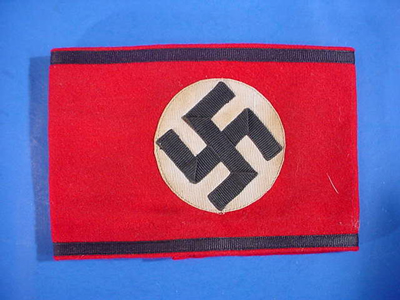 |
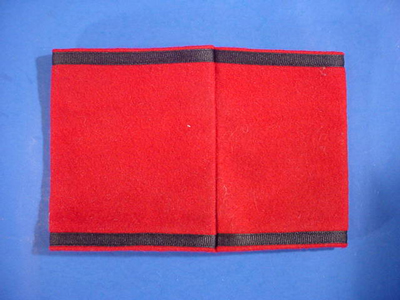 |
Allgemeine SS Armband (Item SS 37-11b; SS 34-1) |
||||
DESCRIPTION:The absolute perfect specimen, this one is 5 ¼ inches wide with the red cotton band with the black borders and white circle with swastika. The circle and swastika are patterned in the corduroy look with twisted fibers that lay parallel (similar to twill) to one another to form the cloths distinct pattern. PRICE: SOLD |
||||
|
|
|
|
“Der grosse Wandtappich” "The Great Tapestry" (Item ART 17-19a, SS-37-12) |
DESCRIPTION: When our advisor R. Johnston visited and interviewed Professor and former  Oberführer Karl Diebitsch in Tegernsee, he intently listened as the professor spun the tales of the Allach porcelain legend that was so beloved to him. Diebitsch and his sister, Frau Elsie Seifert, told Johnston about the very beautiful and profoundly meaningful tapestries that Karl designed and she wove and constructed. These tapestries invariably told fascinating stories and they probed the mythos of the Teutonic past and proclaimed the glories of the National Socialist Third Reich. After the disastrous end of the Second World War, practically all of these wonderful art pieces disappeared into what seemed to be consummate oblivion. Professor Diebitsch seemed to feel that the tapestries were even more important to the National Socialist mythos than even the Allach porcelain and the Allach firm which he was, by the way, the founder of. At the time, Mr. Johnston was attempting to write a book on Allach porcelain and even more importantly he was gathering research on the tapestry of the Ahnenerbe Stiftung that hung in the offices of this wonderful heritage foundation based in Berlin. Professor Karl Diebitsch (January 1899–August 1985) was an artist personified, and he was the designer responsible for most of the regalia used by the Oberführer Karl Diebitsch in Tegernsee, he intently listened as the professor spun the tales of the Allach porcelain legend that was so beloved to him. Diebitsch and his sister, Frau Elsie Seifert, told Johnston about the very beautiful and profoundly meaningful tapestries that Karl designed and she wove and constructed. These tapestries invariably told fascinating stories and they probed the mythos of the Teutonic past and proclaimed the glories of the National Socialist Third Reich. After the disastrous end of the Second World War, practically all of these wonderful art pieces disappeared into what seemed to be consummate oblivion. Professor Diebitsch seemed to feel that the tapestries were even more important to the National Socialist mythos than even the Allach porcelain and the Allach firm which he was, by the way, the founder of. At the time, Mr. Johnston was attempting to write a book on Allach porcelain and even more importantly he was gathering research on the tapestry of the Ahnenerbe Stiftung that hung in the offices of this wonderful heritage foundation based in Berlin. Professor Karl Diebitsch (January 1899–August 1985) was an artist personified, and he was the designer responsible for most of the regalia used by the  to include the officer’s model chained to include the officer’s model chained  dagger and the well-known black dagger and the well-known black  uniform and also the uniform and also the  and police (Degen) ‘sword.’ It was he that did the original (entwurf) “designs” for all the most important tapestries that had and police (Degen) ‘sword.’ It was he that did the original (entwurf) “designs” for all the most important tapestries that had  themes. He received one of the top art prizes at the House of German Art for his remarkable oil painting titled “Mutter” (“Mother”). He also designed many of the Reich’s postage stamps. When Mr. Johnston visited Prof. Diebitsch the learned man did at one point describe how he came to be the designer of these wonderful tapestries and told Mr. Johnston that it was his sister, Elsie Seifert, that actually wove these wonderful Wandteppiche (tapestries) along with an assistant by the name of Fraulein Stronika. Their firm in Munich, if we remember right, was called München-Gobelin. When listening to Dr. Diebitsch as he described his many tapestries, there came a time when Frau Seifert gave Mr. Johnston quite a few original pictures of tapestries that she had created from the designs of her illustrious and highly talented brother. One thing that utterly fascinated Mr. Johnston was a certain artwork that both the professor and his sister described as ‘Der grosse Wandteppich”–“The Great Tapestry.” This, it would seem, was the most important and most beautiful one that they had ever produced. It was thought to be hung outside or inside the main entrance to Adolf Hitler’s office in the Reich’s Chancellery in Berlin. It may, however, have hung in the House of German Art in Munich before going to its final destination and it’s also possible that it never got to the Reich’s Chancellery and we can, I suppose, be grateful that it did not, since the chancellery was entirely gutted and all contents burned by the vicious barbarian hordes that steamrolled over all of Berlin. Diebitsch and his sister were deservedly proud of all their tapestries, but this one was not only their pride and joy, but they thought it to be the most important one produced as it depicted German glory through the ages. Unfortunately, however, they did not have a single picture of it. Evidently there were numerous pictures of it in a special album that Frau Seifert
put together back in the era, but the album was stored at the offices of München-Gobelin Wandteppichwerk and the building was completely burned when allied bombs hit the display and storage units and destroyed many other precious artworks as well as this precious album. Mr. Johnston does remember that they told him this tapestry splendidly imparted the romance and history of the First, Second, and Third Reichs with symbols depicting all these empires and it had heraldic shields that included the Wappen or crests of several of the most important districts of the united Reich and the Holy Roman Empire. This remained stuck in Johnston’s mind over the years since his meeting with the professor and he often thought he would absolutely love to see a picture of this fabulous work of the weaver’s art. However, he figured and was sure he never would. Then! In May 2014, he saw to his absolute amazement suddenly that there was a giant tapestry that was featured in the auction offerings of Mohawk Arms in New York. The tapestry was being called the “N.S. Reichstag National Culture-Gobelin Tapestry.” The minimum bid was shown to be $25,000 and amazing that it did not bring it, but it definitely takes a person steeped in history and culture to appreciate a masterwork such as this. Unfortunately, I did not see it until after the auction was concluded and I couldn’t have handled it at that time in any case, even though my advisor, R. Johnston thought it to be definitely the most important purchase that could ever be accomplished and he was positive that here was the actual Grosse Wandteppich but he did not see it, either, until the auction was over. He was and is sure that it is most assuredly the very same “great tapestry” as described by Professor Diebitsch and Frau Seifert. Later, it came up again in another auction, but still it was with a very substantial starting bid. This was included in the “History Hunter Auction” where it was featured with a minimum bid of $25,000, but again we did not buy it. Why? Frankly, we knew it was worth a great deal more but the item came up again just when we had a crisis in hand. Then, miraculously, we finally had a last chance to buy it from the original owner at a time when we were able to do so with the welcome help of a well-known dealer in the field. This was one of the greatest highlights of any career in this particular line. The dealer knew that of all the collectors and dealers in this field that Germania International would be almost singular in a true appreciation and knowledge of such an important cultural item like this. In addition, of course, I personally can attribute this to the knowledge of R. Johnston, an astute historian of long standing. This piece is more culturally important than any of the wonderful tapestries dedicated to the astounding Third Reich mythos, and this one, Der grosse Wandteppich, is surely the most important of all! themes. He received one of the top art prizes at the House of German Art for his remarkable oil painting titled “Mutter” (“Mother”). He also designed many of the Reich’s postage stamps. When Mr. Johnston visited Prof. Diebitsch the learned man did at one point describe how he came to be the designer of these wonderful tapestries and told Mr. Johnston that it was his sister, Elsie Seifert, that actually wove these wonderful Wandteppiche (tapestries) along with an assistant by the name of Fraulein Stronika. Their firm in Munich, if we remember right, was called München-Gobelin. When listening to Dr. Diebitsch as he described his many tapestries, there came a time when Frau Seifert gave Mr. Johnston quite a few original pictures of tapestries that she had created from the designs of her illustrious and highly talented brother. One thing that utterly fascinated Mr. Johnston was a certain artwork that both the professor and his sister described as ‘Der grosse Wandteppich”–“The Great Tapestry.” This, it would seem, was the most important and most beautiful one that they had ever produced. It was thought to be hung outside or inside the main entrance to Adolf Hitler’s office in the Reich’s Chancellery in Berlin. It may, however, have hung in the House of German Art in Munich before going to its final destination and it’s also possible that it never got to the Reich’s Chancellery and we can, I suppose, be grateful that it did not, since the chancellery was entirely gutted and all contents burned by the vicious barbarian hordes that steamrolled over all of Berlin. Diebitsch and his sister were deservedly proud of all their tapestries, but this one was not only their pride and joy, but they thought it to be the most important one produced as it depicted German glory through the ages. Unfortunately, however, they did not have a single picture of it. Evidently there were numerous pictures of it in a special album that Frau Seifert
put together back in the era, but the album was stored at the offices of München-Gobelin Wandteppichwerk and the building was completely burned when allied bombs hit the display and storage units and destroyed many other precious artworks as well as this precious album. Mr. Johnston does remember that they told him this tapestry splendidly imparted the romance and history of the First, Second, and Third Reichs with symbols depicting all these empires and it had heraldic shields that included the Wappen or crests of several of the most important districts of the united Reich and the Holy Roman Empire. This remained stuck in Johnston’s mind over the years since his meeting with the professor and he often thought he would absolutely love to see a picture of this fabulous work of the weaver’s art. However, he figured and was sure he never would. Then! In May 2014, he saw to his absolute amazement suddenly that there was a giant tapestry that was featured in the auction offerings of Mohawk Arms in New York. The tapestry was being called the “N.S. Reichstag National Culture-Gobelin Tapestry.” The minimum bid was shown to be $25,000 and amazing that it did not bring it, but it definitely takes a person steeped in history and culture to appreciate a masterwork such as this. Unfortunately, I did not see it until after the auction was concluded and I couldn’t have handled it at that time in any case, even though my advisor, R. Johnston thought it to be definitely the most important purchase that could ever be accomplished and he was positive that here was the actual Grosse Wandteppich but he did not see it, either, until the auction was over. He was and is sure that it is most assuredly the very same “great tapestry” as described by Professor Diebitsch and Frau Seifert. Later, it came up again in another auction, but still it was with a very substantial starting bid. This was included in the “History Hunter Auction” where it was featured with a minimum bid of $25,000, but again we did not buy it. Why? Frankly, we knew it was worth a great deal more but the item came up again just when we had a crisis in hand. Then, miraculously, we finally had a last chance to buy it from the original owner at a time when we were able to do so with the welcome help of a well-known dealer in the field. This was one of the greatest highlights of any career in this particular line. The dealer knew that of all the collectors and dealers in this field that Germania International would be almost singular in a true appreciation and knowledge of such an important cultural item like this. In addition, of course, I personally can attribute this to the knowledge of R. Johnston, an astute historian of long standing. This piece is more culturally important than any of the wonderful tapestries dedicated to the astounding Third Reich mythos, and this one, Der grosse Wandteppich, is surely the most important of all!The Tapestry The tapestry as far back as we can locate its history was sold by famed militaria dealer Tony Oliver in England to the well-known U.S. collector Jerry Davis about 45 years ago and during the time Oliver owned it he very unfortunately rented it out to the MGM film studio to be used in probably the movie that was even worse than the filth and genocidal murder depicted in the film Inglourious Basterds or even Rage. Brad Pitt and Lee Marvin should be drawn and quartered along with the rest of the miscreants like Quentin Tarantino who produces such garbage. Luckily, the tapestry only revealed the very bottom of itself and only for a few seconds and its brilliant integrity was not soiled by its misuse in the rotten film The Dirty Dozen. The tapestry was sold by Oliver to Mr. Davis for $10,000.00 in 1968. It shows the three Germanic Reichs while employing the symbolic eagles of each of these empires. We know that the Third Reich was a continuum of the Carolingian Empire and that of course is the double-headed eagle depicted at the base of the work and then above this is the eagle of the Second Reich with the eagle of the Hohenzollern Prussian Monarchy in the middle of its chest. Then above and of course dominant, is the eagle and swastika of the Third Reich. All through the tapestry are enjoyning bands with the names of the various historical districts that made up these proud and noble Reichs, and along with this can be seen the shields of these districts all in full vibrant color. This is an entirely handwoven Gobelin (not applique). Germania International has long been specializing in important Third Reich tapestries. Please read about such works of art at ART 17-19 on our site. There you will see the OKW tapestry that we thought was the most important tapestry of Third Reich origin ever offered and it certainly is and was until miraculously we found this one. No tapestry could exceed this one!! Among the twelve embroidered shields there are included the Wappen arms of Über Oestreich, Schlesian, Anhalt, Pfalz, Sachen, Ostfriesland, Tyrol, Brandenburg, Franken, Boehmen, Deutschordensland, and Nieder Oestreich. Other areas are named on the series of connecting legends. All three eagles are embroidered in shades of silver/gray/black and are more pronounced with the addition of other colors emphasizing crown, sword, orb, and oak leaves. The background consists of subdued shades of brown/tan/dull gold-brown. The absolute utter magnitude of this monumental tribute to the glory of what was once Germany (pre-Merkel) is astounding and if it survives and someday if sanity prevails it will be considered a true treasure of the Western experience–“Deutschland, Deutschland über alles, über alles in der Welt.” PRICE: For now it will be priced upon request. Serious inquiries only. |
|
|
Rare SS Tradition’s Badge of the Allgemeine- |
|
DESCRIPTION: When we bought all the various silver insignia from the elderly jeweler in Stuttgart a few years ago, he told us that some of the items were prototypes designed at the behest of NSDAP (Nazi Party) and such leaders as Himmler, Göring, and, of course, the central offices of the NSDAP. They would forward a design to him and he would often improve on it or make it as proposed. Some of the articles that we found in the collection were unique in that they were never actually approved or distributed. This particular great-looking insignia was designed by the jeweler upon a suggestion by Karl Wolf, the chief of personal staff to SS-Reichsführer Heinrich Himmler. His rank was that of SS-Obergruppenführer and one of his duties was as procurement official. In other words, anything that anyone would supply to the SS would be ordered by General Wolf and approved by him. So, this silver insignia was essentially a project or an Entwurf by the general and the jeweler. We were told that it was to be a pin-back decoration to be worn on the tunic where the party badge and other awards were worn. The meaning of this badge was to signify that the wearer was what was referred to as an “Alter Kämpfer” (Old Fighter) having SS enlistment going back to 1925 or earlier. In 1929, the SS numbered 280 men and they were considered Hitler’s personal bodyguard detachment known even then as the Schutzstaffel (SS) and with their sharp, black uniforms they later became the Allgemeine-SS and were considered to be an elite organization by party members and the general population. After the 1933 Machtergreifung (seizure of power) by the NSDAP, the SS began to expand into a massive organization. By March 1933, it had increased to over 204,000 members and in 1934 the SS organization housed three different subordinate commands: Allgemeine-SS SS-Verfügungstruppe SS-Totenkopfverbände. This one being absorbed into the Waffen-SS in 1942. The Badge The badge as we have pointed out would have been an honorary traditions Abzeichen (badge) to demonstrate that the wearer was a loyal SS man in what is known as the Kampfzeit (Time of Struggle). This badge, however, was an uncompleted project and never adopted, but the jeweler did have a few samples in his shop that subsequently were purchased by us with the massive amount of other silver jewelry and insignia that we acquired. It actually could be considered one of the rarest of all SS insignia even though never worn. The badge features the SS runes surmounted by the earliest form of the SS eagle and skull that resemble the cap insignia worn on the kepis of the early uniforms. It is about 1 ¾ inches high and the SS roundel is about 1 inch wide. The son of the elderly jeweler told me that his father designed a tinny that was for commemoration of some SS event that he used in designing this badge .This man was known to have designed literally hundreds of day badges (Tag Abzeichen) known in collector circles as tinnies. On the back, the retaining pin is of the standard type used on day badges and the stamp is clearly “800” silver. It is a very neat looking insignia and prodigiously rare. PRICE: $700.00 and I would think that to be a bargain for an SS prototype. I wonder how long it will be before the usual shysters get to copy it. |
|
Fabulous Replica of SS-Totenkopf Death's Head Ring
Please refer to item designator in parentheses in all correspondence. Please E-mail for any additional information you may need.If you prefer, contact 'Germania' at PO Box 68, Lakemont, GA 30552 or call at 706.782.1668. Please! do not call during the wee hours of the morning. The best time for calling us is between 10am and 12 noon and between 9 and 11 pm eastern time. |


